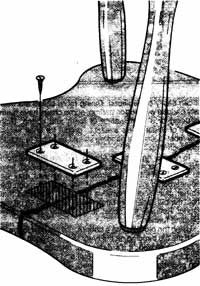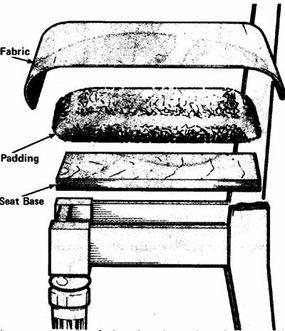How to Repair a Chair Seat
Many people would agree that the most important part of a chair is where you sit. A wooden chair seat that is split or needs to be replaced will be an obvious spot for you to perform repairs.
Split Seats
Advertisement
Split chair seats can be repaired with a series of 1/8-inch dowels (wooden pegs) along the break and reinforced with metal mending plates. The seat must be completely removed for doweling.
Drill holes for the dowels in each side of the broken seat, about 1 inch deep (or as deep as possible) and spaced about 4 to 6 inches apart. Use a doweling jig, clamped to the broken seat, to drill the dowel holes. Dowel center points can also be used, but they aren't as accurate. Cut and score each dowel as above, 1/4 inch less than the total length of the dowel holes.
Apply glue to one end of each dowel, and insert the dowels into the holes along one side of the broken seat; then apply glue to the protruding dowel ends and to the broken edge, and join the two parts. Tap the pieces of the seat together with a rubber or wooden mallet, and wipe off any excess glue. Lightly clamp the glued seat, and let it dry for at least two days. For extra strength, you can add metal mending plates to span the break, as above -- four plates should be adequate. Finally, reassemble the chair.
Inserting Chair Seats
Chair seats set in or on frames are usually boards or plywood covered with padding and cloth. These seats seldom split, but when they do the simplest solution is to replace the seat with a new piece of plywood -- 3/8-inch thickness is best. If 3/8-inch plywood won't fit properly after the padding has been added, you may have to use 1/4-inch plywood, but anything less than this will not provide the needed support. Use the old chair seat as a template or pattern to cut out the new one.
Padded chair seats are usually held to the frame with screws driven through glue blocks. Look carefully for these screws; the cloth covering the padding may hide them. Remove all fasteners, and replace them the same way to hold the new chair seat.

If the upholstery on insert seats is worn or damaged, it can easily be replaced. Dining room chairs are usually padded with cotton batting. Some chairs have foam padding or a combination of foam and cotton. Both types of padding are available precut for chair seats. For most chairs, the padding should be about 3/4 inch to 1 inch thick.
To recover an insert chair seat, remove the seat from the chair. The seat is usually a piece of plywood, held to the chair frame by screws; the screws may be counterbored into the frame or may go up through the corner glue blocks. Remove the tacks or staples that hold the old upholstery fabric to the seat, and lift off the fabric. Refinish the chair, if necessary, before proceeding further.
Using the old fabric as a pattern, cut the new fabric to fit. If the old padding on the chair seat is in good shape, it can be reused; if it's damaged, replace it with new padding. You may be able to fluff and smooth old cotton padding; if it's badly flattened, add a layer of foam padding to build the seat cushion up to 3/4 to 1 inch.
Lay the new fabric flat, wrong side up, and center the padded seat on it upside down. Fold the edges of the fabric up over the seat, stretching it firmly onto the plywood; if desired, tape the fabric firmly down with masking tape. Starting at the center of one side, fold the fabric under and attach it to the seat with a staple gun using heavy-duty staples. If the new fabric is very heavy, flathead upholstery tacks may be more secure. Set staples or tacks 1 to 11/2 inches apart along the side of the seat.

When the first side is completely attached, restretch the fabric; then staple or tack the opposite side. Turn the seat over and smooth the padding. Be sure the fabric is straight, with no wrinkles. Then turn the seat over again, and fasten the other two sides. At the corners, fold the fabric in to miter it neatly; if necessary, staple or tack each layer separately. Finally, staple a scrap piece of the new fabric to the seat, in case repairs are necessary in the future. Replace the chair seat in the frame, and resecure it. Replace all the screws, and tighten them firmly.
As you've seen, chairs take a lot of abuse and, therefore, need a lot of repairs. The same goes for the legs and feet on heavy furniture. We'll show you how to make these fixes in the next section.
